
홈페이지 http://www.disappearing-computer.net
"사라지는 컴퓨터" 프로젝트는 정보기술이 어떻게 일상생활의 사물과 환경에 융합이 될 수 있는지를 알아보기위한 목적을 가지고 있으며, 오늘날 컴퓨터로 인해 가능했던 것들을 능가하거나 또는 부족하더라도, 사람들의 생활을 지원해주고 발전시키기 위한 새로운 방법을 찾아보고자 하는 것이다.
이 프로젝트는 특히 3가지의 목표를 가지고 있다.
- Create information artefacts based on new software and
hardware architectures that are integrated into everyday objects.
(New Architectures,
Embedding into everyday Objects)
- Look at
how collections of artefacts can act together, so as to produce new behaviour and new
functionality.
(Working Together, Emerging Functionality)
- Investigate the new approaches for designing for collections of artefacts
in everyday settings, and how to ensure that people's
experience in these new environments is coherent and engaging.
(Designing and Prototyping Artefacts, Coherence, Engagement )
미션 설명
To
see hofw information technology can be diffused into everyday objects and
settings, and to see how this can lead to new ways of supporting and enhancing
people's lives that go above and beyond what is possible with the computer
today.
Specifically, the initiative looks at how to make ‘information artefacts’ based on new software and
hardware architectures that are integrated into everyday objects.
It looks at
how collections of artefacts can act together, so as to produce new behaviour
and new functionality.
It investigates the
new approaches for designing for collections of artefacts in everyday settings,
and how to ensure that people’s experience in these new
environments is coherent and engaging.
미래 비전
A vision of
the future is one in which our world of everyday objectsand places becomes
infused and augmented with information  processing and
exchange.
processing and
exchange.
In this vision, the technology providing these capabilities is
unobtrusively merged with real world objects and places, so that in a sense it
disap-pears into the background, taking
on a role more similar to electricity
-
an invisible pervasive medium.
As a consequence, human-centred
notions, such as real objects and everyday settings, can come into foreground,
rather than the computer-centric ones which have determined the evolution of the
computer-as-we-know it.
It offers the opportunity of seeing how objects can become
augmented with new properties and qualities and how these can be designed to
enrich everyday living in completely different ways.
Artefacts will be
able to adapt and change, not just in a random fashion but based on how people
use and interact with them. Together, new functionalities and new forms of use
will emerge that will enrich everyday life, resulting in an everyday world that is more
more ‘alive’ and ‘deeply intercon-nected’ that our current day
understanding.
비전으로의 도전
As much of the
above represents un-charted territory, the aim of the disappearing
computer
is to explore the underlying concepts and methods that will ‘set the
trends’
for future development.
In this spirit, the initiative will focus on
three inter-linked objectives:
 The
initiative addresses these three objectives with a number of independent
research projects that have been selected from the
call for proposals. Individually, projects address specific topics; collectively
they address the three objectives as a whole. In addition, promising and
complementary work that emerges from the various projects is able to be
integrated by new projects that can be created throughout the duration of the
initiative.
The
initiative addresses these three objectives with a number of independent
research projects that have been selected from the
call for proposals. Individually, projects address specific topics; collectively
they address the three objectives as a whole. In addition, promising and
complementary work that emerges from the various projects is able to be
integrated by new projects that can be created throughout the duration of the
initiative.
In order to maintain a sense of direction and coherence
across all the projects, a number of support activities has been defined. A network made up of a
representation of all project partners will run these activities.
The initiative addresses these three objectives with a number of independent research projects and a number of support activities run by a network made up of a representation of all project partners.
[목표 1] Creating Artefacts.
In the vision
of the ‘disappearing computer’, information artefacts are future forms of
everyday objects that represent a merging of current everyday objects (tools,
appliances, clothing, etc) with the capabilities of information processing and
exchange (based on sensors, actuators, processors, mircosystems, etc).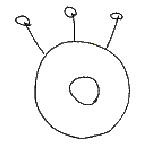
These artefacts have the capability of communicating with
other artefacts based on local (typically wireless) networks, as well as
accessing or exchanging information at a distance via global networks. In this
way, these artefacts posses the capability of both local and global
inter-working.
Individually, artefacts may have a small range of capabilities but together can exhibit a much broader range of behaviours. Alternatively, in certain cases, they may be designed to individually have a wider range of functions, but still working within an ensemble.
This objective focuses on how to create individual artefacts, particularly ones that will have the attributes of openness and connectivity, so that together they can form an open and adaptable system. How they can work together using this as a basis, is taken up in objective 2.
■ New Architectures
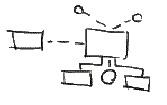 The creation of
artefacts requires research on new software and hardware architectures,
particularly ones that:
The creation of
artefacts requires research on new software and hardware architectures,
particularly ones that:
- Accommodate trade-offs between networking, computing, and power consumption.
- Form part of an open system that allows for wireless communication with other artefacts, for example to connect with global networks.
- Allow for adaptive behaviour, for example through the design of adaptive software architectures, or re-configurable hardware.
- Allow for an awareness of their context, for example with a system of sensors.
- Enable an artefact to be modular, either from the software or hardware points of view.
■Embedding into Everyday Objects
In order
to make information artefacts, the IT components have to fit them unobtrusively.
This requires research into ways of merging information technology
with objects and materials , including for
example:
, including for
example:
- Methods and techniques for adding-on or embedding IT components.
- Techniques for miniaturising components so as to allow easy embedding.
- Coating, or sticking components onto objects, or interweaving them with their constituent materials.
- Research could also consider approaches that would make it easy
for people to embed IT components into everyday objects themselves, for example,
with ‘do-it-yourself’ toolkits.
[목표2] Emerging Functionality
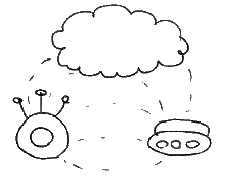 The functionality of an
artefact corresponds to the range of functions it exhibits or the experience it
provides. In reality we may expect a range of different kinds of artefacts, some
general purpose and some quite specific.
The functionality of an
artefact corresponds to the range of functions it exhibits or the experience it
provides. In reality we may expect a range of different kinds of artefacts, some
general purpose and some quite specific.
Even if an
individual artefact has limited functionality, it can have more advanced
behaviour when grouped with others. The aim is to look at how collections of
artefacts can be made to work together, and in particular how they provide
behaviour or functionality that exceeds the sum of their
parts.
The basis for new functionality to emerge is due to the fact that artefacts have properties as described in the first objective, for instance:
- They are Modular
- They can Communicate with others
- They can adapt and learn from previous events
- They can be placed in various locations
These properties lay the basis for collections of artefacts to be able to behave as a complex interacting system. The main aim of this objective to see how to take advantage of this inherent complexity so as to allow for the behaviours and functionalities of collections artefacts to be changeable and emergent.
Because artefacts can be re-configured, or recombined by people and because they can adapt and evolve, their collective behaviour is not static, and collections of artefacts can evolve to produce new behaviours. This is not just a random behaviour, but one that is guided by how artefacts are used or configured by people.
As a consequence, people are given ‘things’ with which to make ‘new things’, rather than only being supplying with fixed and un-changeable tools. This requires a ‘re-think’ about the ways in which tools should be conceived of and designed, and this is taken up further in objective 3.
In order to lay the foundations for new functionality to emerge from collections of artefacts, this objective considers two main topics:
■Working Together
Artefacts have
to be able to work together in order to allow new ‘collective’ functions to
emerge. As a basis for this, research is needed into: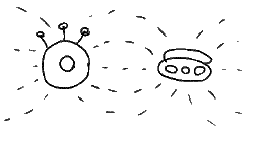
- The ways in which artefacts communicate with other artefacts or other information sources (either globally or locally) and the protocols they should use.
- The structuring of different kinds of artefacts into collections or ‘families’, each with a different role and level of influence.
- The design of new forms of ‘adaptive operating systems’ that would provide a platform for more general software across a range of artefacts.
■Emerging Functionality
Given that
artefacts can communicate, adapt and are modular, the specific ways in which
functionality can be designed for collections of artefacts have to be
researched.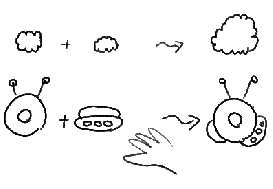
This should consider the ways in which functionality can be constructed and the specific ways or conditions for new functionality to emerge. Some indications are outlined below:
- Because artefacts are modular means that parts of them (either from the software, hardware or physical aspects) can be constructed, deconstructed or mixed, or added on to other artefacts. These kinds of changes would in turn create a new hybrid artefact with a new functionality. Combinations or various artefacts would lead to new functionality that would go beyond what individual artefacts could do.
- The fact that artefacts can communicate and can be aware of other artefacts, means that under certain conditions, artefacts could ‘synergize’ to produce new properties and behaviour that they otherwise they would not exhibit. For example, the proximity of a group of artefacts could trigger an interaction between them and a new functionality would become possible. This principle ‘non-linear addition’ or synergy could also be applied to certain groups of artefacts interacting over a distance.
- The fact that an artefact can learn or adapt from a history of past events, means that this knowledge can trigger new functionality that for example, emerges with time. An individually adaptive artefact may also communicate with other adaptive artefacts so that a group would produce a more complex behaviour.
[목표3] People's Experience
As described
in the previous two objectives, collections of artefacts represent a ‘radical
distribution’ of computing and information processing that can inter-work to
deliver new functionality and lead to new patterns of behaviour. 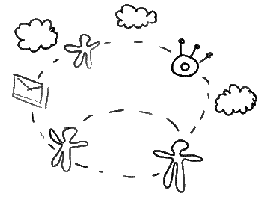
It is the
integration of these concepts with real-world settings and with real objects,
that offers opportunities for new ways of supporting people’ s everyday
activities - ways that go above and
beyond what the personal computer (pc)
can offer today.
In this respect, one can imagine groupings of artefacts could substitute some of the functions that the pc can perform today, however in a more distributed fashion and based a more natural form of interaction.In other cases, one can imagine groupings of artefacts designed to take advantage of the new context and support people’s activities in a completely different ways.
It is therefore necessary to address ways in which people’s activities can be supported or enhanced in such new environments. The basis for this is to consider how to design artefacts or how to design for collections of them. Furthermore it is important to see how they can lead to coherent experience in real world settings and how people can participate in them.
■Designing and Prototyping Artefacts
 The nature of
information artefacts, as described in objective 1
and objective 2,pose a number
The nature of
information artefacts, as described in objective 1
and objective 2,pose a number
of
challengesas regards how artefacts should be designed. This includes for
example:
- How to design an individual artefact, and how to integrate utility design with software/hardware constraints.
- The design of the functionality of an individual artefact and how this can be combined with that of others.
- Research on how to design for collections of interacting artefacts and how to design in the context of a collective and emerging functionality.
- The use of iterative prototyping and new evaluation methods.
■Coherence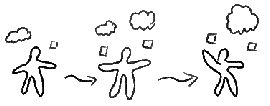
A world full of interacting artefacts could easily confuse people. Research is needed in order to make sure that environments are coherent and understandable. This could include for example:
- Ways to integrate artefacts with real places and locations.
- The use of metaphors, cognitive or semantic models, to guide the design of environments.
- Approaches that ensure ‘seamless interaction’, for example, for an activity that takes place across different locations and different stages in time.
■Engagement
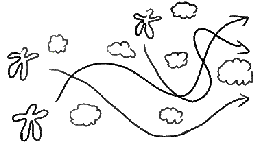 In
contrast to concentrated engagement in one location (as with a pc), the
distributed nature of a collection of artefacts in real locations leads to a
range of research issues on how to support people’s activities in this context,
for example:
In
contrast to concentrated engagement in one location (as with a pc), the
distributed nature of a collection of artefacts in real locations leads to a
range of research issues on how to support people’s activities in this context,
for example:
- The ways in which both individuals and groups of people can participate in such environments.
- The design of engagement that is appropriate to an activity. This includes active engagement that requires concentration, through to relaxed participation that is ‘laid-back’, enjoyable or fun.
- The ways in
which sequences of interaction and experience can be structured. For example,
the use of ‘interactive narratives’, that can guide or engage people in space
and time, and the ways in which such narratives can encompass pre-scripted
elements as well as emergent, or unexpected events.